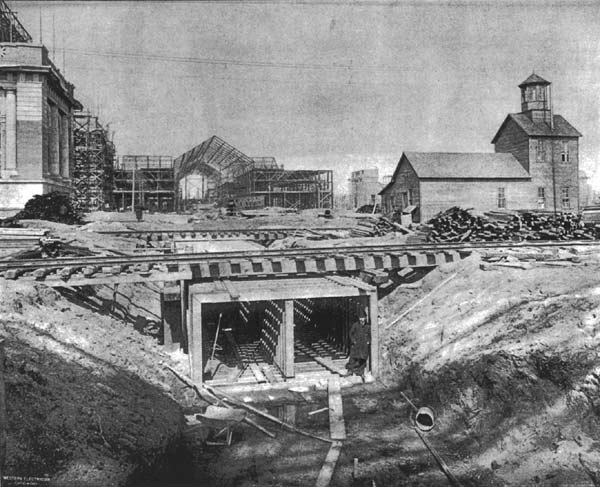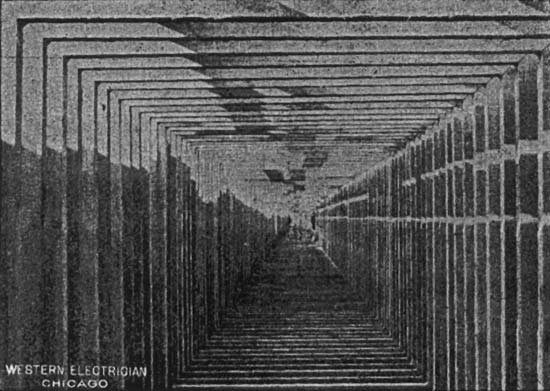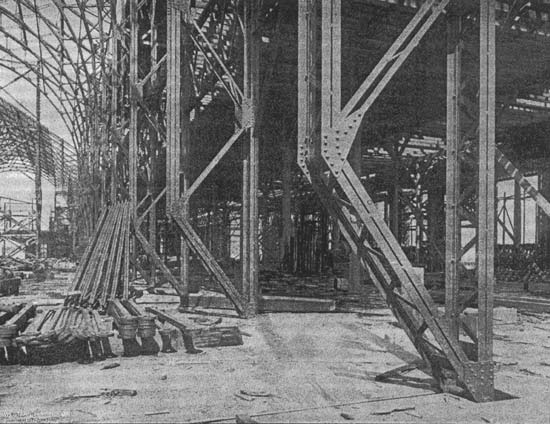[Trade Journal]
Publication: Western Electrician
Chicago, IL, United States
vol. 10, no. 14, p. 201-202, col. 1-3,1-3
Electricity at the World's Fair.
Interesting electrical features of the present stage of construction work at the World 's Fair grounds are shown in the illustrations presented on this and the succeeding page. Figs. 1 and 2 give an excellent idea of the work done on the electrical subways which are to contain the conductors for power and light. The former shows a view taken from a point just north of machinery hall looking north. It shows the big double conduit leading from the generating station in the machinery building as it appears in process of construction. Directly ahead is the electricity building, while a corner of the administration building is shown at the left. The latter will undoubtedly be the most handsome and imposing of all the buildings when completed. The picture shows the appearance of the staff covering. In Fig. 2 is given an interior view of the long stretch of single conduit extending north and south along the western side of the great manufactures building. The top had not been boarded over at the time the photograph was taken, and the lights and shadows on the side of the subway are plainly marked. About 3,000 feet of subway have so far been laid. An article on the "Electrical Subways for the World's Fair," with map and diagrams, was published in the WESTERN ELECTRICIAN of November 28, 1891. In view of the advanced stage of the work it is permissible to reproduce the following paragraph:
The greater portion of the conduit will be exactly eight feet and four inches square. The outer material will be two-inch tarred plank laid on stringers one foot apart, These stringers will be eight inches wide and they will support the inner skin of the conduit, which will be an inch thickness of cement plaster laid on metal lathing. The larger tunnels will be six feet six inches wide inside, and the smaller size four feet three inches. All will be six feet six inches high in the clear, so that a man may walk through without difficulty. In the larger conduits there will be a passageway in the center, with a row of cross-arms on either side, while in the smaller ones there will be but one row of cross-arms, with a side passageway. Man-holes will be provided at convenient distances. The cross-arms will be supported on iron castings especially designed for the purpose, which will be placed twenty feet apart, and bolted to the stringers. Glass insulators of a size sufficient to accommodate the largest cables will be used on the cross-arms. All wires must be covered with water-proof insulation. The conduits will be laid, on an average, eighteen inches below the surface of the ground, and will at all times be above the level of the lake. The interior will have the appearance of a concrete tunnel, and there will be ample room for all the wires necessary.
| |||
| Fig. 1 Electricity at the World's Fair. |
Fig. 3 is a reproduction of a photograph taken on the floor of the electricity building last week. It shows the springing point of the great iron arches that support the roof. The iron work of the building is now practically completed. The frame work for all the towers up to the main entrance line is now finished. About one-third of the gallery floor has been laid and the roof boarding completed over all the gallery trusses. Within a few days the staff men will be at work covering up the exterior frame work of the building with their white composition. For a month they have been at work in a temporary factory on the flooring of the great building, under the direction of Peter Taparelli, an intelligent Italian. A large stock of moulded material has already been accumulated, and the work will be finished in two or three months.
The trouble over the bids for the arc lights at the World's Fair has been settled by a compromise. Captain Eugene Griffin, vice-president of the Thomson-Houston Electric company, appeared before the committee on grounds and buildings on March 23d. Captain Griffin said that there was no intention to "squeeze" the fair, and that the Thomson-Houston company was willing to be perfectly fair, if its bid had been made under any misapprehension of the conditions. The speaker made a good impression on the committee, and Col. R. C. Clowry, Director H. B. Stone and Frederick Sargent, electrical engineer of the construction department, were appointed to confer with Captain Griffin and endeavor to reach an amicable understanding. This conference was held on Friday of last week at the Chicago club, and lasted from 9:30 A. M. until 2:30 P. M. The situation was talked over in a friendly aspect in all its various phases, with the result that Capt. Griffin finally agreed to furnish 2,500 lights at the rate of $20 each, promising, in addition, to supply 1,000 more at the same rate if called upon to do so. On their part the World's Fair representatives agreed that the
| |||
| Fig. 2. Electricity at the World's Fair. |
company should not be required to furnish any superintendence or help of any kind in the operation of the plant during the fair. At the same time it was agreed that the Standard Electric company of Chicago should be given 1,000 lights and the Western Electric company 500 lights on the same basis. The former company had previously offered to supply a large portion of the lights needed at a lower rate than that of the Thomson-Houston bid — said to be $22 per lamp. Thus, 5,000 of the 6,000 lamps are provided for. There is still some talk of seeking the remainder from foreign sources, and April 6th has been fixed as the date of Mr. Sargent's departure for Europe. At this writing the matter is still unsettled, however. The arrangement gives general satisfaction and all concerned appear to be glad that an agreement has been reached.
The committee on grounds and buildings has rejected all the bids for generators for motor service save that of the Eddy Electric Manufacturing company, which offered to supply 300 kilowatts for the transportation building free of cost. It adopted a recommendation that this company be offered the privilege of furnishing from 1,000 to 1,500 horse power capacity at the rate of $2.50 per horse power. In the event of the company agreeing to furnish 1,500 horse power capacity on the terms mentioned, all other firms wishing to supply generators for the World's Fair plant must do so free of cost. In case, however, the Eddy company chooses to supply but 1,000 horse power the Mather company will be given an opportunity to furnish the capacity mentioned in its bid (600 kilowatts) at the rate of $2.50 per horse power. "We only care to buy 1,500 horse power out of the necessary 3,300," a construction department official is represented as saying. "We shall get the remainder in the way of exhibits."
| |||
| Fig. 3. Electricity at the World's Fair. |
It will interest all engaged in electrical pursuits to know that Director H. B. Stone, president of the Chicago Telephone company, is mentioned as a possible candidate for president of the local board, to succeed W. T. Baker.
B. E. Sunny, western manager of the Thomson-Houston company, will retire from the directory at the next election. In view of ths present and prospective relations of the World's Fair and his company, he does not deem it proper to remain on the board. Upon the recommendation of Chief of Construction Burnham, the committee on grounds and buildings has agreed to let the contract for furnishing boilers of 10,000 horse power capacity to the following companies for the amounts indicated:
Heine Boiler company of St. Louis, 2,500 horse power, $20,000; Campbell & Zell company of Baltimore, Md., 2,500 horse power, $20,000; Mills Boiler company of London, England 2,000 horse power, $16,000; Stearns Manufacturing company of Erie, Pa., 1,000 horse power, $8,000; National Water-Tube Boiler company of New Brunswick, N. J., 1,000 horse power, $7,300; Abendroth & Root of New York, 1,000 horse power, $8,000. Total horse power, 10,000, $79,300.
The contractors, for these prices, provide for the erection of boilers capable of sustaining a pressure of 125 pounds per square inch. The boilers are to be furnished with all fittings, attachments and appurtenances, walled in ready for connection with mains and water supply, the contractor to build smoke stacks and flues, and operate the boilers during the period of their use and remove them at the close of the fair. The exposition furnishes fuel and water only.



